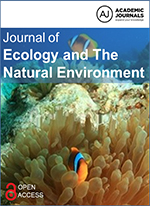
Assessing the spatial distribution of bamboo species using remote sensing in Cameroon
Year of publication: 2020
Author: B. Neba, R. Kaam, M. Tchamba, L. Zapfack, C. Chimi, A. Tanougong
Abstract
Bamboo resource assessment has witnessed great interest in the world with very little attention in the Congo Basin forests. This study was initiated to assess bamboo species distribution in Cameroon with respect to Agroecological Zones (AEZ), using remote sensing. Forty-eight sheets of Landsat 8/Operational Land Imager (OLI) and the Thermal Infrared Sensor (TIRS) instruments’ images were mosaiced with the Envi 5.3 software. The bamboo index (BI) was calculated and used to identify wild bamboo-growing regions in Cameroon. Maps of bamboo growing regions helped in ground truthing. GPS coordinates were used to validate the bamboo presence with an accuracy of 78%. The result showed that bamboo spatial area statistics was 794.60, 451 308.36, 241 295.87, 302 989.41 and 219 094.67 ha in Sudano-Sahel, Guinea Savannah, Western Highlands, Monomodal rainfall forests and Bimodal rainfall forest, respectively with a total of 1 215 482.91 ha. Bambusa vulgaris Schrad. ex J.C.Wendl.; Oxytenanthera abyssinica (A. Rich.) Munro; Phyllostachys sp.; Yushania alpina K. Schum; Ochlandra travancorica (Bedd.) Gamble; Dendrocalamus strictus (Roxb.) Nees; Phylostachys atrovaginata C. S. Chao & H.Y.Chou; Phyllostachys aurea Rivière & C. Rivière, were found in Cameroon. O. abyssinica was dominant in Agroecological zones 1 and 2; P. aurea in Agroecological zones 3; and B. vulgaris in respectively Agroecological zones 4 and 5. These results can orientate policies and planning towards a sustainable bamboo sector development and mitigating the effects of climate change in Cameroon.
